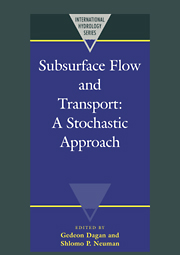Book contents
- Frontmatter
- Contents
- List of contributors
- Preface
- Acknowledgments
- I INTRODUCTION
- II SUBSURFACE CHARACTERIZATION AND PARAMETER ESTIMATION
- III FLOW MODELING AND AQUIFER MANAGEMENT
- IV TRANSPORT IN HETEROGENEOUS AQUIFERS
- V FRACTURED ROCKS AND UNSATURATED SOILS
- 1 Component characterization: an approach to fracture hydrogeology
- 2 Stochastic analysis of solute transport in partially saturated heterogeneous soils
- 3 Field-scale modeling of immiscible organic chemical spills
- VI A VIEW TO THE FUTURE
3 - Field-scale modeling of immiscible organic chemical spills
Published online by Cambridge University Press: 04 December 2009
- Frontmatter
- Contents
- List of contributors
- Preface
- Acknowledgments
- I INTRODUCTION
- II SUBSURFACE CHARACTERIZATION AND PARAMETER ESTIMATION
- III FLOW MODELING AND AQUIFER MANAGEMENT
- IV TRANSPORT IN HETEROGENEOUS AQUIFERS
- V FRACTURED ROCKS AND UNSATURATED SOILS
- 1 Component characterization: an approach to fracture hydrogeology
- 2 Stochastic analysis of solute transport in partially saturated heterogeneous soils
- 3 Field-scale modeling of immiscible organic chemical spills
- VI A VIEW TO THE FUTURE
Summary
INTRODUCTION
Problems involving the flow of multiple fluid phases in porous media arise in a number of scientific and engineering disciplines. In electrical engineering, packed bed reactors are widely used to facilitate various homogeneous (single-phase) as well as heterogeneous (multiphase) reactions. In certain processes, coexisting liquid and gas phases occur which call for the application of multiphase flow models to facilitate design optimization. Historically, the greatest impetus for development of models for multiphase flow has come from petroleum engineering, induced by the lure of more efficient oil and gas recovery from hydrocarbon reservoirs. Early investigations tackled the problem of two-phase flow in gas–oil and oil–water systems, facilitating subsequent development of models for three-phase flow of gas, oil, and water in reservoir rocks.
Also interested in flow in geologic media, but operating at shallower depths, hydrologists, agricultural engineers, and soil physicists have for many years been concerned with fluid movement in air–water porous media systems prompted by motives ranging from groundwater resource utilization to optimizing water use by agricultural crops. More recently, environmental concerns have led to an increased interest in the movement of fluids in the so-called vadose or unsaturated zone interposed between the atmosphere and the groundwater (saturated zone).
Many potential groundwater contaminants are introduced at or near the soil surface via atmospheric deposition, spills, leakage from underground tanks, subsurface waste disposal, etc. Soluble components may migrate in the aqueous phase through the vadose zone to groundwater. Volatile components may move by mass flow and diffusion in the gas phase.
- Type
- Chapter
- Information
- Subsurface Flow and TransportA Stochastic Approach, pp. 207 - 228Publisher: Cambridge University PressPrint publication year: 1997
- 1
- Cited by



